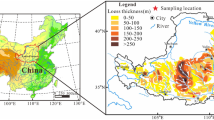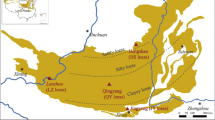Abstract
Microbial-induced calcium carbonate precipitation (MICP) treatment of consolidated loess has the advantages of high efficiency and environmental protection. In this study, changes in the microscopic pore structure of loess before and after MICP treatment were compared and quantified, combined with test results at different scales, to better understand the mechanisms of MICP-consolidated loess. The unconfined compressive strength (UCS) of MICP-consolidated loess is significantly increased, and the stress–strain curve indicates improved strength and stability of the loess. X-ray diffraction (XRD) test results show that the signal strength of calcium carbonate crystals is significantly enhanced after loess consolidation. The microstructure of the loess was determined by scanning electron microscopy (SEM). The loess SEM microstructure images are quantitatively analyzed using comprehensive image processing methods (including gamma adjustment, grayscale threshold selection, median processing). The changes in microscopic pore area and average pore sizes (Feret diameter) of the loess before and after consolidation are described. More than 95% of the pores consist of pores with a pore area of less than 100 μm2 and an average pore size of less than 20 μm. The total percentage of pore numbers with pore areas of 100–200 and 200–1000 μm2 decreased by 1.15% after MICP consolidation, while those with 0–1 and 1–100 μm2 increased. The percentage of pore numbers with an average pore size greater than 20 μm decreased by 0.93%, while the 0–1, 1–10, and 10–20 μm increased. Particle size distributions revealed a significant increase in particle size after MICP consolidation, with an increase of 89 μm in D50.

















Similar content being viewed by others
Data availability
Please feel free to contact the corresponding author if you require the data.
References
Adjabi S, Nouaouria MS, Djebabla W (2021) Treatment of collapsible soils with granulated blast furnace slag and calcined eggshell waste. Civil Environ Eng Rep 31(2):138–162. https://doi.org/10.2478/ceer-2021-0024
An QY, Zhang QS, Zhang X, Zhang JQ (2021) Bridging the gap between engineering properties and grouting reinforcement mechanisms for loess in eastern China: taking Jinan loess as an example. Bull Eng Geol Env 80(5):4125–4141. https://doi.org/10.1007/s10064-021-02201-w
Derbyshire E (2001) Geological hazards in loess terrain, with particular reference to the loess regions of China. Earth Sci Rev 54(1–3):231–260. https://doi.org/10.1016/S0012-8252(01)00050-2
Gao CH et al (2020) Field study on the treatment of collapsible loess using vibratory probe compaction method. Eng Geol 274:1–11. https://doi.org/10.1016/j.enggeo.2020.105715
Garg R, Garg R, Eddy NO (2023) Microbial induced calcite precipitation for self-healing of concrete: a review. J Sustain Cement-Based Mater 12(3):317–330. https://doi.org/10.1080/21650373.2022.2054477
He SY et al (2020) The study on loess liquefaction in China: a systematic review. Nat Hazards 103(2):1639–1669. https://doi.org/10.1007/s11069-020-04085-7
Kianimehr M, Shourijeh PT, Binesh SM, Mohammadinia A, Arulrajah A (2019) Utilization of recycled concrete aggregates for light-stabilization of clay soils. Constr Build Mater 227:116792. https://doi.org/10.1016/j.conbuildmat.2019.116792
Li H et al (2020) Tunnelling-induced settlement and treatment techniques for a loess metro in Xi’an. Adv Civil Eng 2020:1–20. https://doi.org/10.1155/2020/1854813
Liu XJ, Pan CF, Yu J, Fan JY (2021) Study on micro-characteristics of microbe-induced calcium carbonate solidified loess. Crystals 11(12):1–12. https://doi.org/10.3390/cryst11121492
Ludwig W et al (2009) Three-dimensional grain mapping by x-ray diffraction contrast tomography and the use of Friedel pairs in diffraction data analysis. Rev Sci Instrum 80(3):1–10. https://doi.org/10.1063/1.3100200
Ma EL et al (2022) Failure analysis and treatments of a loess tunnel being constructed in ground fissure area. Eng Fail Anal 134:1–16. https://doi.org/10.1016/j.engfailanal.2022.106034
Mei Y et al (2021) Field test study on dynamic compaction in treatment of a deep collapsible loess foundation. Bull Eng Geol Env 80(10):8059–8073. https://doi.org/10.1007/s10064-021-02343-x
Meng Z, Liyi C, Shanyong W, Honggang W (2020) Experimental study of the microstructure of loess on its macroscopic geotechnical properties of the Baozhong railway subgrade in Ningxia, China. Bull Eng Geol Env 79(9):4829–4840. https://doi.org/10.1007/s10064-020-01816-9
Murugan R, Sundararaghavan A, Dhami NK, Mukherjee A, Suraishkumar G (2022) Importance of carbon to nitrogen ratio in microbial cement production: insights through experiments and genome-scale metabolic modelling. Biochem Eng J 186:108573. https://doi.org/10.1016/j.bej.2022.108573
Nawarathna THK, Nakashima K, Fujita M, Takatsu M, Kawasaki S (2018) Effects of cationic polypeptide on CaCO3 crystallization and sand solidification by microbial-induced carbonate precipitation. Acs Sustain Chem Eng 6(8):10315–10322. https://doi.org/10.1021/acssuschemeng.8b01658
Qian C, Ren X, Rui Y, Wang K (2021) Characteristics of bio-CaCO3 from microbial bio-mineralization with different bacteria species. Biochem Eng J 176:108180. https://doi.org/10.1016/j.bej.2021.108180
Qian CX, Yu XN, Zheng TW, Chen YQ (2022) Review on bacteria fixing CO2 and bio-mineralization to enhance the performance of construction materials. J Co2 Utilization 55:101849
Schluter S, Sheppard A, Brown K, Wildenschild D (2014) Image processing of multiphase images obtained via X- ray microtomography: a review. Water Resour Res 50(4):3615–3639. https://doi.org/10.1002/2014WR015256
Sharma M, Satyam N, Reddy KR (2021) Rock-like behavior of biocemented sand treated under non-sterile environment and various treatment conditions. J Rock Mech Geotech Eng 13(3):705–716. https://doi.org/10.1016/j.jrmge.2020.11.006
Sridhar S, Bhatt N, Suraishkumar G (2021) Mechanistic insights into ureolysis mediated calcite precipitation. Biochem Eng J 176:108214. https://doi.org/10.1016/j.bej.2021.108214
Sun X et al (2021a) Liquefaction resistance of biocemented loess soil. J Geotech Geoenviron Eng 147(11):04021117. https://doi.org/10.1061/(ASCE)GT.1943-5606.0002638
Sun XH et al (2022) Sand foreshore slope stability and erosion mitigation based on microbiota and enzyme mix-induced carbonate precipitation. J Geotech Geoenviron Eng 148(8):04022058. https://doi.org/10.1061/(Asce)Gt.1943-5606.0002839
Sun XH, Miao LC, Tong TZ, Wang CC (2019) Study of the effect of temperature on microbially induced carbonate precipitation. Acta Geotech 14(3):627–638. https://doi.org/10.1007/s11440-018-0758-y
Sun X, Miao L, Wang H, Chen R, Guo X (2021b) Improvement of characteristics and freeze-thaw durability of solidified loess based on microbially induced carbonate precipitation. Bull Eng Geol Env 80(6):4957–4966. https://doi.org/10.1007/s10064-021-02241-2
Sun X, Moiao L, Chen R, Wang H, Wu L (2023) A revised porous media model of microbially induced carbonate precipitation for loess solidification. J Geotech Geoenviron Eng 149(6):04023031. https://doi.org/10.1061/JGGEFK.GTENG-10309
Tang CS et al (2020) Factors affecting the performance of microbial-induced carbonate precipitation (MICP) treated soil: a review. Environ Earth Sci 79(5):1–23. https://doi.org/10.1007/s12665-020-8840-9
Tang G, Wang G, An Y, Zhang H (2019) Graphene oxide on microbially induced calcium carbonate precipitation. Int Biodeterior Biodegradation 145:1–17. https://doi.org/10.1016/j.ibiod.2019.104767
Wang L et al (2020) Characterization of the collapsible mechanisms of Malan loess on the Chinese Loess Plateau and their effects on eroded loess landforms. Hum Ecol Risk Assess 26(9):2541–2566. https://doi.org/10.1080/10807039.2020.1721265
Wang YZ, Soga K, Dejong JT, Kabla A (2019) A microfluidic chip and its use in characterising the particle-scale behaviour of microbial-induced calcium carbonate precipitation (MICP). Geotechnique 69(12):1086–1094. https://doi.org/10.1680/jgeot.18.P.031
Weng XL, Zhou RM, Rao W, Wang D (2021) Research on subway shield tunnel induced by local water immersion of collapsible loess. Nat Hazards 108(1):1197–1219. https://doi.org/10.1007/s11069-021-04727-4
Westall F et al (2000) Polymeric substances and biofilms as biomarkers in terrestrial materials: implications for extraterrestrial samples. J Geophys Res-Planets 105(E10):24511–24527. https://doi.org/10.1029/2000JE001250
Wu Q, Jia CT, Chen SB, Li HQ (2019) SBAS-InSAR based deformation detection of urban land, created from mega-scale mountain excavating and valley filling in the loess plateau: the case study of Yan’an city. Remote Sensing 11(14):1–20. https://doi.org/10.3390/rs11141673
Yu XN, Rong H (2022) Seawater based MICP cements two/one-phase cemented sand blocks. Appl Ocean Res 118:102972. https://doi.org/10.1016/j.apor.2021.102972
Yu XN, Yang HQ, Wang H (2022) A cleaner biocementation method of soil via microbially induced struvite precipitation: a experimental and numerical analysis. J Environ Managt 316:115280. https://doi.org/10.1016/j.jenvman.2022.115280
Zamani A et al (2021) Mitigation of liquefaction triggering and foundation settlement by MICP Treatment. J Geotech Geoenviron Eng 147(10):04021099. https://doi.org/10.1061/(Asce)Gt.1943-5606.0002596
Zhang HN et al (2022) Physical-mechanical properties of microbially induced calcite precipitation-treated loess and treatment mechanism. J Mt Sci 19(10):2952–2967. https://doi.org/10.1007/s11629-022-7336-3
Zhang Y, Hu ZQ, Chen H, Xue T (2018) Experimental investigation of the behavior of collapsible loess treated with the acid-addition pre-soaking method. KSCE J Civ Eng 22(11):4373–4384. https://doi.org/10.1007/s12205-017-0170-4
Zhao M, Chen LY, Wu HG, Guo W, Ye CW (2018) Computer microscopic test study on the suitability of modified polyimide grease used to improve collapsible loess railway subgrade. Concurr Computation-Practice Experience 30(24):1–10. https://doi.org/10.1002/cpe.4900
Zheng ZY, Li XA, Wang L (2021) A longitudinal analysis of collapsibility with predictions over the southeastern Loess Plateau in China. Sci Rep 11(1):1–17. https://doi.org/10.1038/s41598-021-02623-2
Fan CY, Liang SY, (2012) Selection of threshold in SEM image processing of soil, The 9th National Congress of Engineering Geology. Qingdao: 732–737.
Sharma B, Singh A, Joshi S, Reddy MS (2022) Utilization of sandstone waste in cement mortar for sustainable production of building materials through biomineralization. J Sustain Cement-Based Mater: 1–9. https://doi.org/10.1080/21650373.2022.2116500
Yu XN, Pan XH (2022) One-phase improvement of sandy soil using seawater-based soybean-induced carbonate precipitation. J Sustain Cement-Based Mater: 1–10. https://doi.org/10.1080/21650373.2022.2142985
Yu X, Zhang Q, (2023) Microbially/CO2-derived CaCO3 cement and its microstructural and mechanical performance. J Sustain Cement-Based Mater: 1–13. https://doi.org/10.1080/21650373.2023.2178539
Zhen Y, Liu B (2021) Experimental study on the performance of improved collapsible loess mixture with concrete crushed gravel, IOP Conference Series: Earth and Environmental Science. IOP Publishing, pp. 1–8.
Acknowledgements
This work was financially supported by the 2021 Graduate Innovation Fund Project of the China University of Geosciences, Beijing (No. ZD2021YC059).
Author information
Authors and Affiliations
Contributions
X.Y. Zhou: design experiment, data curation, methodology, software analysis, first to final draft writing. G.H. Wang and H.N. Zhang: funding support, administration, and review and editing. C.Q. Jia and G.W. Tang: data validation; review and editing. All authors contributed to the manuscript revision and read and approved the submitted version.
Corresponding author
Ethics declarations
Ethical approval
Not applicable.
Consent to participate
Not applicable.
Consent for publication
Not applicable.
Competing interests
The authors declare no competing interests.
Additional information
Responsible Editor: Philippe Garrigues
Publisher's note
Springer Nature remains neutral with regard to jurisdictional claims in published maps and institutional affiliations.
Rights and permissions
Springer Nature or its licensor (e.g. a society or other partner) holds exclusive rights to this article under a publishing agreement with the author(s) or other rightsholder(s); author self-archiving of the accepted manuscript version of this article is solely governed by the terms of such publishing agreement and applicable law.
About this article
Cite this article
Zhou, X., Wang, G., Zhang, H. et al. Multi-scale analysis of the mechanism of microbially induced calcium carbonate precipitation consolidation loess. Environ Sci Pollut Res 30, 78469–78481 (2023). https://doi.org/10.1007/s11356-023-27862-w
Received:
Accepted:
Published:
Issue Date:
DOI: https://doi.org/10.1007/s11356-023-27862-w




